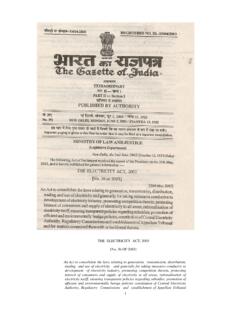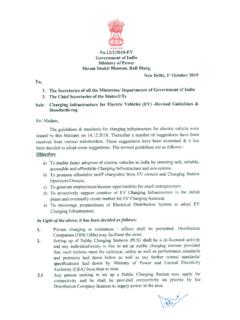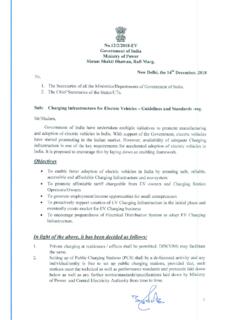Transcription of GUIDELINES REVAMPED DISTRIBUTION SECTOR SCHEME …
1 GUIDELINES REVAMPED DISTRIBUTION SECTOR SCHEME REFORMS-BASED AND RESULTS-LINKED Nodal Agency Nodal Agency 1 Abbreviations ABC Aerial Bunched Cable ACS Average Cost of Supply AI Artificial Intelligence AMI Advanced Metering Infrastructure AMR Automated Meter Reading AT&C Aggregate Technical and Commercial ARR Average Revenue Realised DBFOOT Design Build Finance Own Operate & Transfer DBT Direct Benefit Transfer DMS DISTRIBUTION management system DRC DISTRIBUTION Reforms Committee DPR Detailed Project Report DT DISTRIBUTION Transformer EMD Earnest Money Deposit ERP Enterprise Resource Planning FI Financial Institution FMS Feeder Monitoring system GBS Government Budgetary Support HVDS High Voltage DISTRIBUTION system ICT Information and Communication Technology IT Information Technology LD
2 Liquidated Damages MBC Metering, Billing and Collection MDB Multilateral Development Bank ML Machine Learning MSME Micro, Small and Medium Enterprises MYT Multi Year Tariff NBFC Non-Banking Financial Company NFMS National Feeder Monitoring system OT Operational Technology PMA Project management Agency PPP Public Private Partnership RPO Renewable Purchase Obligation T&D Transmission & DISTRIBUTION ToD Time of Day TOTEX Total Expenditure TPA Tripartite
3 Agreement SAIDI system Average Interruption Duration Index SAIFI system Average Interruption Frequency Index SBD Standard Bidding Documents STQC Standardization Testing and Quality Certification UG Under-ground UT Union Territories 2 Chapter 1. Introduction A well-functioning electricity infrastructure is essential for the success of a modern economy. 24x7 availability of reliable, quality and affordable power is key to economic development of the country. Power SECTOR has witnessed tremendous growth over the past five years in generation, transmission and universal access to electricity.
4 India is surplus in power generation today. The continued progress in inter-state and intra-state transmission network has removed transmission bottlenecks and created sufficient transmission capacity to transmit electricity generated from one region to another. In the DISTRIBUTION SECTOR , Government of India has been assisting the States / DISTRIBUTION Companies (DISCOMs) through various schemes since 2014, namely Deen Dayal Upadhyaya Gram Jyoti Yojana (DDUGJY); Pradhan Mantri Sahaj Bijli Har Ghar Yojana (SAUBHAGYA); and Integrated Power Development SCHEME (IPDS). The DISTRIBUTION system has been strengthened under DDUGJY and IPDS in rural and urban areas respectively. As a result of the implementation of these schemes, India has achieved universal electricity access by connecting ~28 million households in 18 months under Saubhagya.
5 This was the largest expansion of access anywhere in the world in such a time frame. Implementation of these schemes has also resulted in improved access to electricity. An independent survey shows that an average Indian household gets almost hours of power supply every day, with urban areas getting 22-24 hours and rural areas getting 20 hours. Steps have also been taken for automation and use of Information Technology (IT) in DISTRIBUTION SECTOR under IPDS and R-APDRP which includes the establishment of Data Centres, GIS mapping of consumers, Asset Mapping, Online energy auditing & accounting, Consumer care centres, AMI meters on feeders & DISTRIBUTION Transformers, provision of Smart Metering to reduce losses etc. in urban areas. Despite the above measures, consumers do not get reliable 24x7 electricity in many parts of the country.
6 Aggregate Technical and Commercial (AT&C) losses and the Average Cost of Supply-Average Revenue Realized (ACS-ARR) gap continue to be high. This sub optimal performance of the DISTRIBUTION SECTOR is due to structural and management deficiencies and some remaining weaknesses in the infrastructure. The DISCOMs need to focus on improving their operational efficiencies & financial sustainability; and improve consumer services to be able to meet the desired consumer service standards. The above requires large scale reforms in DISTRIBUTION SECTOR and schemes that would enable the DISCOMs to reduce losses to make them financially sustainable and operationally efficient. It is with this aim and the Government of India s commitment for providing 24x7 uninterrupted, quality, reliable and affordable power supply, that the REVAMPED Reforms Based and Results Linked DISTRIBUTION SECTOR SCHEME has been formulated by Ministry of Power for supporting DISCOMs to undertake reforms and improve performance in a time bound manner.
7 The REVAMPED Reforms-based and Results-linked, DISTRIBUTION SECTOR 3 SCHEME seeks to improve the operational efficiencies and financial sustainability, by providing financial assistance to DISCOMs for strengthening of supply infrastructure based on meeting pre-qualifying criteria and achieving basic minimum benchmarks in reforms. The REVAMPED DISTRIBUTION SECTOR SCHEME has the following parts: Part A Metering & DISTRIBUTION Infrastructure Works: Facilitating in installing prepaid smart meters for all consumers along with associated AMI, communicable meters for DTs & Feeders, ICT including Artificial Intelligence (AI), Machine Learning (ML), etc. based solutions for power SECTOR and a unified billing and collection system1; DISTRIBUTION infrastructure works as required for strengthening and modernizing the system as well as measures for loss reduction.
8 The infrastructure strengthening works will include separation of Agriculture feeders to enable implementation of the KUSUM SCHEME , Aerial Bunch cables and HVDS for loss reduction, replacement of HT/LT lines as required, construction of new/ upgradation of substations, SCADA and DMS system etc. Each DISCOM/ State will draw up the SCHEME according to its requirement with the end objective of reducing losses and ensuring 24 x 7 supply. Part B - Training & Capacity Building and other Enabling & Supporting Activities: Supporting and enabling components, such as Nodal Agency fee, enabling components of MoP (communication plan, publicity, consumer awareness, consumer survey and other associated measures such as third-party evaluation etc.)
9 , up-gradation of Smart Grid Knowledge Centre, training and capacity building, awards and recognitions etc. Ongoing approved projects: Schemes of IPDS, DDUGJY along with PMDP-2015 for the erstwhile State of Jammu & Kashmir are being subsumed in this SCHEME to be implemented as per their extant GUIDELINES and under their existing terms & conditions. No new projects will be sanctioned under these schemes but projects already sanctioned under IPDS & DDUGJY will be eligible to receive funds up to 31st March 2022 under this SCHEME . However, projects sanctioned for Ayodhya, Uttar Pradesh under IPDS and also projects sanctioned under PMDP 2015 will get funds till 31st March 2023. The REVAMPED Reforms based and Results Linked DISTRIBUTION SECTOR SCHEME will have an outlay of ,03,758 crore with an estimated GBS from Central Government of ,631 crore.
10 It is envisaged that about Rs. 200 crores will be spent by the State Governments towards reforms support in the form of consultancy. Office Memorandum issued by the Ministry of Power in respect of Reforms 1 Nodal Agency / MoP may develop a unified billing and other software, which may be utilized by the Government DISCOMs / Power Departments of the country (as may be decided by Monitoring Committee), keeping in view issues such as interoperability, data security, and consumer privacy, which shall be optional for DISCOMs to use. 4 based and Results Linked DISTRIBUTION SECTOR SCHEME is enclosed as Appendix-I. These GUIDELINES shall be applicable for the clause of the SCHEME . The existing operational GUIDELINES / Standard documents/ procedures shall continue to prevail for implementation of projects sanctioned under DDUGJY, IPDS & PMDP.





